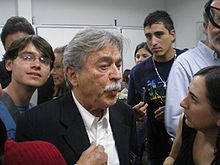Paulo Mendes da Rocha
| Paulo Mendes da Rocha | |
|---|---|

(2009)
|
|
| Born |
25 October 1928 Vitória, Espírito Santo, Brazil |
| Nationality | Brazilian |
| Alma mater | Universidade Presbiteriana Mackenzie |
| Occupation | Architect |
| Awards | Pritzker Architecture Prize (2006) |
| Buildings | Serra Dourada Stadium, Gymnasium in the Paulistano Athletics Club, Pinacoteca do Estado, National Coach Museum |
Paulo Mendes da Rocha (born October 25, 1928 in Vitória (ES)) is a Brazilian architect.
Mendes da Rocha attended the Universidade Presbiteriana Mackenzie College of Architecture, graduating in 1954. Working almost exclusively in Brazil, Mendes da Rocha has been producing buildings since 1957, many of them built in concrete, a method some call "Brazilian Brutalism", arguably allowing buildings to be constructed cheaply and quickly. He has contributed many notable cultural buildings to São Paulo and is widely credited as enhancing and revitalizing the city.
Mendes da Rocha was Professor at the Architecture College of University of São Paulo, known as FAU-USP, until 1998. His work is influenced by Brazilian architect Vilanova Artigas, from the paulist Brazilian School. He was honored with the Mies van der Rohe Prize (2000), the Pritzker Prize (2006) and the Venice Biennale Golden Lion for lifetime achievement (2016)
Saint Peter Chapel, São Paulo (1987)
Patriarch Plaza, São Paulo (2002)
Brazilian Sculpture Museum, Mube, 1988.
São Paulo Pinacotheca, Pinacoteca do Estado, 1993.
...
Wikipedia
